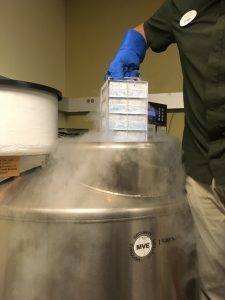Zoo InternQuest is a seven-week career exploration program for San Diego County high school juniors and seniors. Students have the unique opportunity to meet professionals working for the San Diego Zoo, Safari Park, and Institute for Conservation Research, learn about their jobs, and then blog about their experience online. Follow their adventures here on the Zoo’s website.
 This past Thursday, I had the great experience of touring the San Diego Zoo Institute of Conservation Research. We were guided by Chris Tubbs, a Researcher who is part of the Reproductive Sciences team. Dr. Tubbs has worked at the institute for about 10 years and has worked in the Reproductive Sciences team since.
This past Thursday, I had the great experience of touring the San Diego Zoo Institute of Conservation Research. We were guided by Chris Tubbs, a Researcher who is part of the Reproductive Sciences team. Dr. Tubbs has worked at the institute for about 10 years and has worked in the Reproductive Sciences team since.
While touring, we visited the Frozen Zoo, which contains different genetic material including DNA, sperm, eggs, embryos, and live tissue. We learned about the goal of the Frozen Zoo, which is to preserve the many different species that may be threatened or endangered globally. It contains over 10,000 living cell cultures, oocytes, sperm, and embryos representing nearly 1,000 taxa, including one extinct species, the po’ouli. The po’ouli is passerine bird that is native to Maui and went extinct on September 9, 2004. As we were in the Frozen Zoo, we learned all about the northern white rhino and the Rhino Rescue Project, which is the main focus of the research being conducted in Dr. Tubbs’ lab.
As we continued our tour, we toured one of the Reproductive Sciences labs, where we conducted a lab that tested progesterone, which tells whether or not an animal will be or is pregnant. In order to do this, we tested unknown samples against known samples containing varying levels of progesterone. Even though this was just a mock sample and situation, our results supported that this rhino will become pregnant at some point in her life. We also got to interact with different species’ feces, or more simply known, poop. My group had to identify the fecal matter of the following species: giraffe, elephant, koala, and panda. We had to choose the species based on past knowledge, observing the poop, and the size of the animals. Specifically, there was a spherical poop/excrement about the size of a softball, which could not possibly come out of a koala. My group was really good at guessing poop correspondents, so we got all the questions right.
There are many different threats that affect animals worldwide. Most of these threats occur locally in the natural environments where the animals reside. More specifically, these problems can include poaching, urbanization, illegal wildlife trade, and many others caused by humans. Poaching is one of the leading causes of the decline of both the southern and northern white rhino populations. Poaching is extremely harmful to many other species that reside in the same region as the southern white rhino. Due to these issues, Dr. Tubbs and Ms. Felton are attempting to save the northern white rhino species. First, they are working to successfully artificially inseminate a southern white rhino with southern white rhino sperm. So far, two of the six attempts have been successful resulting in two pregnancies. Moreover, it is San Diego Zoo’s hope that one day through in vitro fertilization that a northern white rhino embryo can be implanted into a southern white rhino surrogate. This has never been done before, so this project is just getting started, but if it is completed it could save the northern white rhino from extinction. If successful, this will be a large stepping stone in this field of science, and will lead to many new advancements which will hopefully help other species.
While these issues might not directly affect you, many of these threats are hurting biodiversity worldwide. If I were to leave you with one message, it would be, whether or not you are involved in any wildlife problems, try to make a difference, no matter the size, it will matter. For example, this can be seen with a group at my school called the Green Team. Every weekend, they are doing beach cleanups in order to help out the environment and to save different animals. Whether you get involved in a group like this or if you do it on your own, go out there and make the difference.
Ben, Real World Team
Week Two, Fall Session 2018


